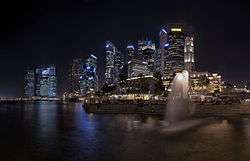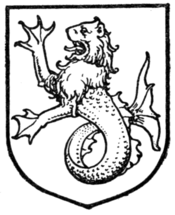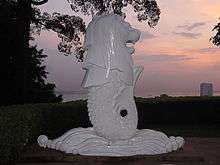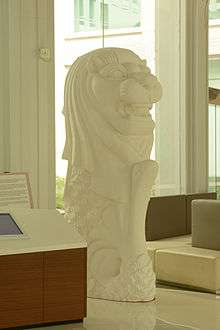Merlion



The Merlion (Malay: Singa-Laut) is a well known marketing icon of Singapore depicted as a mythical creature with a lion's head and the body of a fish. It is widely used as a mascot and national personification of Singapore.[1]
The Merlion was first used in Singapore as the logo for the tourism board.[2] The Merlion is similar to the heraldic sea-lion which occurs in a number of different artistic traditions.
Singapore Merlion
The Merlion is the national personification of Singapore.
Its name combines "mer", meaning the sea, and "lion". The fish body represents Singapore's origin as a fishing village when it was called Temasek, which means "sea town" in Javanese. The lion head represents Singapore's original name—Singapura—meaning "lion city" or "kota singa".
The symbol was designed by Alec Fraser-Brunner, a member of the Souvenir Committee and curator of the Van Kleef Aquarium, for the logo of the Singapore Tourism Board (STB) in use from 26 March 1964 to 1997[3] and has been its trademarked symbol since 20 July 1966. Although the STB changed their logo in 1997, the STB Act continues to protect the Merlion symbol.[4] Approval must be received from STB before it can be used. The Merlion appears frequently on STB-approved souvenirs.
Original statue
On 15 September 1972, then-Prime Minister Lee Kuan Yew officiated the installation ceremony of the Merlion statue.[3] The original Merlion statue used to stand at the mouth of the Singapore River, at the tip of the current The Fullerton Waterboat House Garden with Anderson Bridge as its background. The Merlion is female.
It was conceptualised by the vice-chancellor of the University of Singapore (now known as National University of Singapore) then, Kwan Sai Kheong. Made from November 1971 to August 1972 by the late Singapore sculptor, Lim Nang Seng,[5] it measures 8.6 metres high and weighs 70 tons.[3][2] Its body is made of cement, skin from porcelain plates and eyes from small red teacups. The project cost about S$165,000.[3]
Relocation of original statue
The completion of the Esplanade Bridge, in 1997, blocked the views of the Merlion from the Marina Bay waterfront.[3] By then, the original Merlion location was also no longer the entrance of Singapore River.[3] So, in 2002, the statue and its cub were relocated 120 metres to the current Merlion Park that fronts Marina Bay where it stands on a newly reclaimed promontory in front of The Fullerton Hotel.
Another solution considered—to raise the Merlion on a pedestal at its original location—was deemed unsuitable as the view would still be blocked by the bridge. Other possible relocation sites considered included Nicoll Highway Extension Bridge, Esplanade Park, Esplanade - Theatres on the Bay, a promontory at Marina Centre (near where Singapore Flyer is located now), a promontory site at Bayfront (near the tip of Marina Bay Sands integrated resort) and Kim Seng Park. However, all were either unsuitable or not technically feasible.[3]
The unprecedented feat of relocation began on 23 April 2002, and finished on 25 April. A carefully engineered journey required one barge, two DEMAG AC1600S cranes of 500 tonnes lifting capacity, plus a team of 20 engineers and workers on site. The entire statue was hoisted onto the barge, which then sailed to the new installation site at the current Merlion Park, near the mouth of Singapore River. During the voyage, the statue had to be hoisted from the barge, over the Esplanade Bridge and then back onto the barge, as it was too tall to pass underneath.
Exactly 30 years after it was officially launched, then-Senior Minister Lee Kuan Yew returned on 15 September 2002 to ceremonially welcome the Merlion again – this time in its new home. A viewing deck now stretches over the Singapore River, allowing visitors to pose for a photograph with a front or side view of the Merlion, including a new city skyline backdrop in the picture. The sculpture was aligned to face East, a direction advised to be most auspicious.[2] Relocated, the statue once more spouted water from its mouth, having stopped in its old location since 1998 due to a water pump malfunction. The Merlion now has a new two-unit water pump system with units working alternatively, so a partner is always on standby. The relocation and new site (four times larger than the original) cost S$7.5 million.[2]
Maintenance of original statue
From 5 June till 10 July 2006, the Merlion at Merlion Park underwent maintenance. The last one was right after its relocation. Dirt and stains were removed using high-pressure water streams, and various wear and tear of the statue was mended.[6]
During that period, visitors were greeted with illustrated hoardings and canvases covering the safety nets and scaffolding. The illustrations[7] were designed by Miel, an award-winning senior artist at The Straits Times. The illustration on the canvases made them look like shower curtains, with the Merlion sticking its head out with the shadow of its tail behind the curtain. The illustration on the hoardings showed the Merlion scrubbing himself with a brush and showering using a Merlion shower head spouting water. The Merlion said "EXCUSE ME while i take a shower..." in a speech bubble.
The Merlion on Sentosa was designed and sculpted by an Australian Artist called James Martin. It is made of Glass Reinforced Cement (GRC) over a steel armature that is attached to the centre.[8]
The Merlion Park was temporarily turned into a single-unit hotel suite, as part of an artwork by Tatzu Nishi, for the duration of the 2011 Singapore Biennale.[9]
Damage by lightning
On Saturday, 28 February 2009 at about 4:26 pm the Merlion in the Merlion Park was struck by lightning. A breaking news from 938LIVE local radio showed an image with fragments from the Merlion's head on the ground.
Examination of the damage was done quickly with wooden scaffolding set up on Sunday, 1 March 2009 for workers to take a closer look at the hole. The incident happened as a result of the lack of lightning protection on the Merlion itself.[10]
Merlion statues



These five Merlions in Singapore are the only ones recognised by the STB:[3]
- The 8.6-metre-tall original statue at Merlion Park[11]
- The two-metre-tall cub statue standing behind the original statue
- The 37-metre-tall gigantic replica – with Mouth Gallery Viewing Deck on the ninth storey, another viewing gallery on its head and Sentosa Merlion Shop, and capable of shining laser beams from its eyes – at Sentosa Island[12]
- The three-metre-tall glazed polymarble statue at Tourism Court (near Grange Road) completed in 1995
- The three-metre-tall polymarble statue placed on Mount Faber's Faber Point
Also, a pair of Merlion statues were constructed by the Ang Mo Kio Residential Committee in 1999. Those sit at the entrance of the car park along Ang Mo Kio Ave 1.[13]
Other Merlion statues
Due to the influence of overseas Singaporeans, Singapore investors and friends of the country, variations of the Merlion statue can be found in Japan, China and the United States.[2]
Merlion souvenirs
A wide variety of Merlion souvenirs are sold at tourist areas in Singapore. Some form of Merlion souvenirs include:
- Display model, with smaller ones doubling up as paperweights
- Mini soft toy keychains or mobile phone charms
- Picture frames
- Refrigerator magnets
- Soft toys
- T-shirts
The Merlion in art and popular culture

In anime and TV series
- The Merlion (Japanese: マーライオン) appeared in the influential anime Cowboy Bebop (episodes 18 and 24), where its appearance in an ancient home movie offers Singaporean amnesiac bounty hunter Faye Valentine a clue to her true origins.
- The Merlion featured heavily in Hajime Satō's (佐藤 肇, Satō Hajime) reimagining of Shinjuku in the 2005 anime, Karas.
- The Merlion is featured in episode 11 of Japanese light novel, Seitokai no Ichizon.
- The Merlion is seen in special episode 1 of the manga, Hidamari Sketch.
- The Merlion appears when the lady landlord is searching for an apartment key in Episode 10 of Hidamari Sketch X: "Hoshimittsu".
- The Merlion was used in an exclamation by Kyoko Toshino in episode 8 of "YuruYuri" in response to seeing Chizuru Ikeda drooling.
- In Phineas and Ferb's "Summer belongs to you!", The Merlion was seen when the gang was bouncing around the world in a large rubber ball.
- In the anime Beelzebub, Tatsuya Himekawa had merlion decorations in his house
- The Amazing Race 25 requires teams to search for a clue box in one of five official Merlions in Singapore (Tourism Court, Mount Faber, Sentosa and two in Merlion Park) where only the Merlion in Mount Faber has it.
- The Merlion is seen in episode 1 of the 2013 anime television series, Valvrave the Liberator.
- The Merlion is featured in episode 11 of anime television series, Blast of Tempest.
- The Merlion appears in episode 70 of Cardfight!! Vanguard: Asia Circuit.
- The Merlion was briefly seen in episode 52 of Yu-Gi-Oh! Arc-V.
In gaming
- The Merlion can also be seen in the popular video game Animal Crossing for the Nintendo GameCube, and its sequels, as a decoration.
- The Merlion can be summoned in the DS game, Scribblenauts and Super Scribblenauts.
- The Merlion can be bought as a cash item and be used as a mount in Ragnarok 2 : Advent of Valkyrie.
- The Merlion is also featured in one of the Alien Egg miracle cards of the English version of Animal Kaiser.
- Merlion Virtual Airlines, virtually based in Singapore, is a virtual airline focusing on the free flight simulator, FlightGear, which uses the Merlion as its logo.
In literature
- Edwin Thumboo cemented the iconic status of the Merlion as a personification of Singapore with his poem "Ulysses by the Merlion" in 1979. Due to Thumboo's status as Singapore's unofficial poet laureate and the nationalistic mythmaking qualities of his poetry, future generations of Singaporean poets have struggled with the symbol of the Merlion, frequently taking an ironical, critical, or even hostile stand – and pointing out its artificiality and the refusal of ordinary Singaporeans to accept a tourist attraction as their national icon. The poem "attracted considerable attention among subsequent poets, who have all felt obliged to write their own Merlion (or anti-Merlion) poems, illustrating their anxiety of influence, as well as the continuing local fascination with the dialectic between a public and a private role for poets, which Thumboo (as Yeats before him, in the Irish context) has wanted to sustain as a fruitful rather than a tense relation between the personal and the public." Among the poems of this nature are "Merlign" by Alvin Pang and "Love Song for a Merlion" by Vernon Chan. More recent poems include "Merlion: Strike One" by Koh Buck Song in the 2009 anthology, Reflecting on the Merlion.
- Merlions as a species were fictional characters in Gwee Li Sui's Myth of the Stone (1993), the first full-length graphic novel published in Singapore. They were depicted as calm and wise creatures that fought on the side of good and eventually overcame the dreaded Kraken. Gwee further popularised the iconoclastic image of the spitting Merlion in the early 1990s. It reappeared later with his well-loved poem "Propitiations" in his book of poems Who Wants to Buy a Book of Poems? (1998).
As mascots and performance characters
- For the inaugural Singapore 2010 Summer Youth Olympics, a pair of mascots, Lyo and Merly, were introduced. Merly is a "Merlion-ess cub" based on the Merlion. Her hair is inspired by the lion top half while her fish half is represented in light-blue scales like Godzilla on her body. Unlike the actual merlion, she has hands and legs instead of a tailfin.
- The 37m-tall Sentosa Merlion appeared in the Magical Sentosa show, awakening at the last scene of the show and shining two laser beams out of its eyes at the audience. (Similar to the storyline of the Songs of the Sea show.)
In local parlance
- Singaporeans often substitute the term "Merlion" in lieu of vomiting, in reference of the constant gushing of water from the Merlion's mouth.[14] It is now used by Singaporean medical staff as slang for a patient who has intractable vomiting.
In sculpture
- A small Merlion, complete with a plaque giving information about the original statues, forms part of the decoration in the "Mystic East" area of British theme park Chessington World of Adventures.
- The Merlion was featured– or, depending on point of view, not featured– during the 2005 Venice Biennale in the controversial work "Mike" by artist Lim Tzay Chuen. He had proposed taking the sculpture in the Merlion Park to the Singapore Pavilion at the exhibition,[15] but was refused by the authorities.
- There is also a Merlion statue by artist Romero Britto, located just outside the Universal Studios Singapore.
- A LEGO Merlion statue was designed, constructed, and shipped from Denmark using 134,522 LEGO bricks. It took approximately 777 hours to put together and weighed 300 Kg when completed. This LEGO Merlion statue is currently installed at the Vivo City branch of Toys R Us.
Coordinates: 1°17′13.28″N 103°51′16.88″E / 1.2870222°N 103.8546889°E
References
- ↑ "The Monstrous Merlion: In the Original Sense". Public Art. Archived from the original on 10 September 2014. Retrieved 10 September 2014.
- 1 2 3 4 5 Singapore National Library Board: Singapore Infopedia: "Merlion Statue" <http://infopedia.nl.sg/articles/SIP_938_2004-12-27.html>
- 1 2 3 4 5 6 7 8 "A new home for the Merlion". URA Skyline (July/August 2000). p. 6–8
- ↑ Singapore Tourism Board: "Use of the Merlion Symbol" <"Archived copy". Archived from the original on 2 December 2008. Retrieved 2008-09-08.>
- ↑ Sim Lian Huat
- ↑ http://app.stb.gov.sg/asp/new/new03a.asp?id=5203
- ↑ Miel's illustrations
- ↑ http://merlion.sentosa.com.sg. Retrieved 30 December 2014. Missing or empty
|title=(help) - ↑ Akshita Nanda (1 March 2011). "Merlion hotel fully booked". The Straits Times. Archived from the original on 4 March 2011.
- ↑ Lightning strikes Merlion Archived 5 March 2009 at the Wayback Machine.
- ↑ "Merlion Park". Retrieved 30 December 2014.
- ↑ "Sentosa Merlion". Sentosa. Archived from the original on 16 December 2014. Retrieved 30 December 2014.
- ↑ http://remembersingapore.wordpress.com/ang-mo-kio-merlions/
- ↑ Wong, Tessa (6 August 2015). "The rise of Singlish - BBC News". BBC News. Retrieved 2016-04-08.
- ↑ No Merlion in Singapore's pavilion at Venice Biennale
Further reading
- Analysis of the mythology and meaning of the Merlion from the perspective of country branding in: Koh, Buck Song (2011). Brand Singapore: How Nation Branding Built Asia's Leading Global City. Marshall Cavendish, Singapore. ISBN 978-981-4328-15-9.
External links
| Library resources about Merlion |
| Wikimedia Commons has media related to Sea lions in heraldry. |
| Wikimedia Commons has media related to Merlion. |